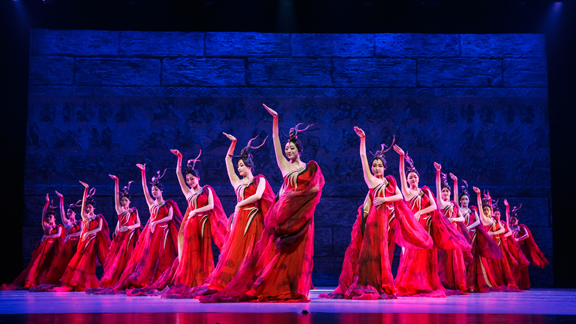Review: China National Opera & Dance Drama Theater Brings PRINCESS ZHAOJUN to Lincoln Center

PRINCESS ZHAOJUN, performed by the China National Opera & Dance Drama Theater, made its New York debut March 21-24 at The David H. Koch Theater at Lincoln Center. The rotating cast of dancers numbers more than 50.
The lavish production has no dialogue, but uses both instrumental and vocal music (which I believe was pre-recorded), along with movement to tell the story of Wang Zhaojun, a real figure in Chinese history. She has been written about in numerous poems and stories for generations.
As the story goes, in about 33 BC, Princess Zhaojun was an imperial concubine, who sacrificed her comfortable life in the Han Dynasty palace to marry Huhanye Chanyu, the Monarch of the Xiongnu. The marriage was agreed upon as a peace treaty to stop the war between the Xiongnu and the Han Dynasty. This required Zhaojun leave her home forever and travel far to live in an area she had never been before. Much to her surprise, as legend tells it, she fell in love with Huhanye Chanyu, and peace was achieved.
The dance theater program performed at Lincoln Center depicts the Princess' story in a prologue, four acts, and an epilogue. The opening scene is grim, showing the dead from the wars between the two groups.
In the first act, the marriage alliance is established. This includes exciting fight choreography by the male dancers, as they perform for the emperors. A fight sequence between two of the men is particularly impressive and intricate. At times, they use weapons, that even if not sharp, could cause injury if either dancer's timing is off. The choreography actually reminds me a little bit of capoeira, as the men sometimes kick over each other's heads, although I'm sure there is no direct influence from the Afro-Brazilian martial art.
In the second act, Zhaojun begins the arduous journey to her new home. When the group stops to camp, she has a dream that shows her the damage the fighting has caused. As a result, she decides to give her whole life to maintaining border peace.
The remaining acts depict the couple's wedding and conflicts between members of the Xiongnu, followed by a terrible epidemic that claims the life of Huhanye Chanyu. Even after his death, Zhaojun continues her commitment to peace.
One of the most moving moments of the evening is Zhaojun's emotional grief dance after the death of her husband. It includes rapid turns and anguished floor work. Afterwards, during a fantasy sequence, Zhaojun dances a rapturous pas de deux with her late husband, including complicated lifts.
.jpg)
There are few pas de deux in the show overall, and all of those are between Zhaojun and Huhanye Chanyu. Most of the dances are either solos, groups of men, or groups of women. The male dances are decidedly masculine and sometimes acrobatic, as most of the men in the story are warriors. The women's dances, in contrast, are exceptionally feminine with delicate movements and flowing fabrics.
While the dancers don't perform en pointe, they are obviously classically trained in ballet. The choreography has some similarities with western ballet, but the movements are often quite different from western styles and, thus, refreshing to those of us who rarely get to see dancers from the east. I particularly loved the placement of the women's hands.
The traditional Chinese orchestral music by Zhang Qu is gorgeous and appropriately dramatic for the life and death elements of the story. The stage and lighting design by Ren Dongsheng is also stunning, but it is perhaps the costume design by Yang Donglin that steals the show. Obviously, no expense was spared in creating this opulent production.
From the royal blue and metallic costumes of the men of Xiongnu to the primitive fur used for the Han Dynasty warriors, the men's costumes are striking. But it's the women's costumes that stand out the most. Colorful and flowing, they sometimes use long, scarf-like sleeves much the same way as fabric is used in Flamenco--flipping it over so that it serves as a versatile prop. In another piece, the women carry each other's long trains in beautiful formations.

Sun Aina's modeling design also deserves a shout out, especially her makeup for the men, who often sport pointy beards and long mustaches, as was apparently the fashion in that period of ancient China.
PRINCESS ZHAOJUN was directed by Kong Dexin. The playwright for the show is Yu Ping, and the choreography is attributed to Tian Ye, Tian Zhuang, Jia Guozhu, and Wu Sha.
This sumptuous show made me anticipate more from this company when they next visit the U.S. from China.
Photo Credits: China National Opera & Dance Drama Theater
Reader Reviews
Videos

